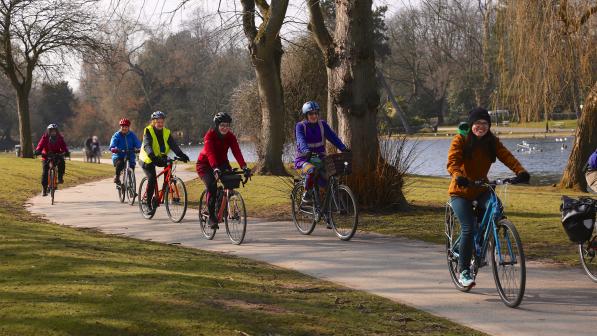These tough times could help create a fresher future for Northern Ireland

Tell us what changes near you could make cycling in lockdown safer
People remark these are strange times, and as we face the pandemic, we’ve become accustomed to living in ‘lockdown’. The irony of the lockdown in the UK is that we are also seeing many more people out and about on foot or on bicycles – some riding for the first time.
Thankfully, the government restrictions in the UK allow us outside for exercise once a day, and it’s now a common sight to see families out riding their bikes together, on roads which were previously far too congested. Should we really consider this ‘strange’, or could this aspect of lockdown be a new ‘normal’ which we aspire to, especially given that Belfast is currently seeing a 25% reduction in air pollution?
We can’t just go back to the way things were, we need to move forward and do things better.
Nichola Mallon, Infrastructure Minister
Nichola Mallon, Infrastructure Minister, tweeted that lockdown has seen a 70% reduction of traffic on the roads, and said, “This lockdown has shown us how things could be. No congestion, cleaner air, safer spaces to walk and cycle. We can’t just go back to the way things were, we need to move forward and do things better.”
The question we must pose then is how do we facilitate this and encourage it? One key way to do so is by converting this now unused road capacity into temporary cycling and walking space.
We have seen examples in major cities all over the world, such as Berlin, New York, Vancouver and closer to home in Dublin. Across Great Britain similar changes are also beginning to take place. Local authorities are starting to reallocate more space for walking and temporary cycle lanes are popping up, enabling commuters and those exercising to maintain safe social distancing.

In Northern Ireland, and particularly in Belfast, we have some great traffic-free cycling routes such as the Lagan Towpath and the Comber Greenway. However, due to the vast increase of people using these greenways we now must think of alternatives to allow people to maintain the two-metre distance, while also having the confidence to ride safely.
With many of our footways being less than two metres wide, the pandemic has highlighted how little space we give to walking and cycling. We now have the chance to rectify this and move away from car-dominated urban places.
Along with Sustrans, Cycling UK is calling on the Department for Infrastructure to create temporary measures to facilitate the increase of walking and cycling and ensure safe social distancing.
These don’t have to be extravagant nor costly. Simple things like extending footways to give pedestrians more space to social distance, or reallocating more road space to existing cycle lanes can be done just using cones and planters .
So far the response has been positive, and, alongside other walking and cycling partners in my role as Cycling UK's engagement officer in Northern Ireland, I’ll be (virtually) meeting the Minister next week to discuss these ideas in more detail. That’s where you come in: let Cycling UK know what measures could make walking and cycling safer in your area, and I will take the best ones straight to the Minister.
Examples could be converting a traffic lane along the Antrim Road, in north Belfast, into a contra-flow cycle lane and extended pavement for pedestrians, enabling key workers, including those at the Mater Hospital, to travel safely by cycling. Or it could be extending the pavement where people are queueing outside shops, to ensure others can pass safely without entering the road.

Beyond the current challenges posed by coronavirus, Belfast also faces significant problems with air pollution, congestion and mental health issues. Cycling and walking can help us defeat all of these.
With fewer on the road, we have a real opportunity to re-imagine what our streets could and should be like, and promote a better quality of life across Northern Ireland through active travel.
With fewer on the road, we have a real opportunity to re-imagine what our streets could and should be like.
Josh Murray, Cycling UK engagement officer in Northern Ireland
Whilst this campaign is a call for temporary cycling and walking infrastructure we must also look to the future, beyond the current lockdown.
Undoubtedly, there will come a time when people go back to work and there will be a return of more vehicles on the road, but it’s likely social distancing requirements will remain. We need this space to keep us safe, especially given that in Wuhan, where Covid-19 originated, the relaxing of lockdown has led to a 32% increase in the use of private cars. Congestion in Northern Ireland was bad enough before Covid-19, we cannot afford for it to get worse post the pandemic.
To quote the Minister herself: “We can’t just go back to the way things were.”
We know there is overwhelming support for creating more space for people walking and cycling. At the start of March, Nichola Mallon helped to launch the Belfast Bike Life report which found 67% of adults in the city, whether they cycled or not, supported building more cycle lanes, even when this would mean less room for other road traffic. How much more public support must there be today when we’ve seen what ‘strange times’ look like?
Implementing the temporary infrastructure will provide a pilot to test what works, what is achievable and determine what can be made permanent. As the saying goes, there is no better time than the present.



